2019-2020 - The stairway of the Quai de l'Horloge

Page

Page
Lighting from above
Lighting from the top
Nicolas Poussin (1594-1665) - The Flood (1660-1664), serie "The seasons"
2018-2019 - Nowhere
2018 - Banks of Seine, Pont-Royal
2016-2017 - Paris, Eastern Railway Station
2011 - The Banks
© Luc Dartois - April 2020
updated in October 2020


The choice is between the stairs which lead to an hidden light and a path which lead to other unknowns. Each way contains its own dangers and grey areas. There is no good or bad choice, only a direction to take.
The menacing mass of the sky could be seen as the premise of the crisis in the making. Indeed, this canvas has been finished in early Februar 2020, the moment when the new corona virus started to spread all over the world.
~
~
~
~
~
~
~
~
~
~
~
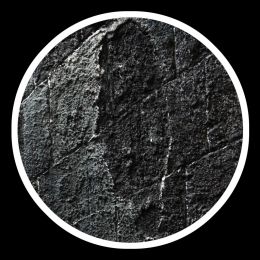
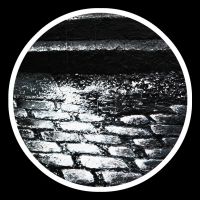
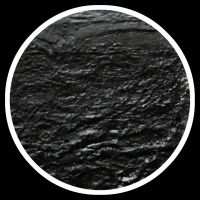
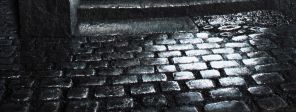
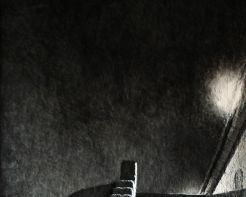
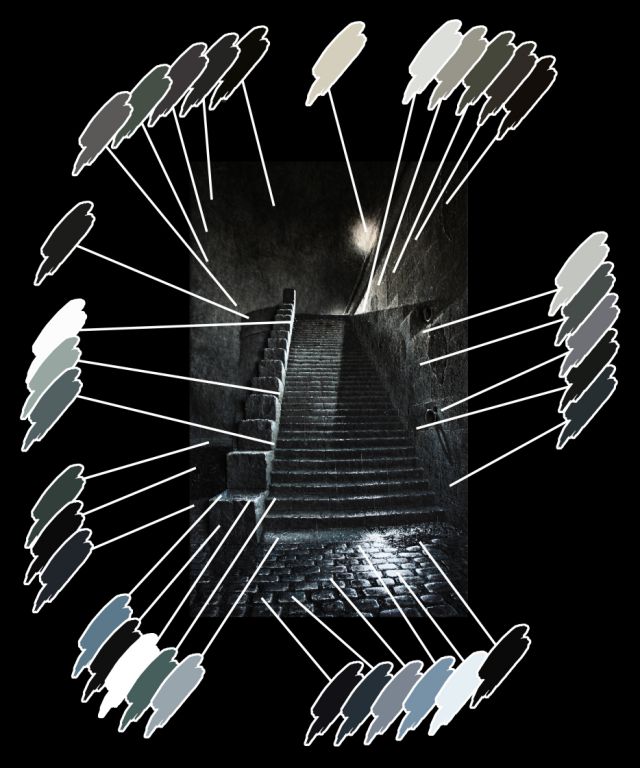


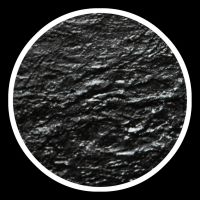


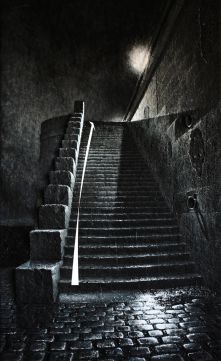

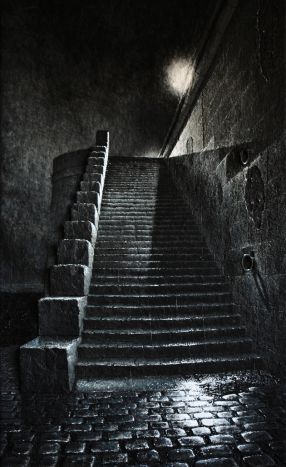

But still, the light remain enigmatic. Here is no hope suggested. On the contrary, an unknown or a danger seems to be concealed.
The focal point between composition lines, the top of the stairs which seems to be the final destination of the viewer, the shadows... all the movement inside the painting is directed to an hidden light in a constant duality between the visible and the invisible.
The stairway, which has long been an ancient civilisation symbol of ascending to a more elevated plane, closer to heaven, doesn't lead here to anything apparent.
Received vision from the outside world or inner vision, the question remains. But in art, questionning doesn't have any value if there is no underpinned vision.
In the background, lights are turning off.
Metaphor of a colapsing world or prelude of darkest periods to come, a simple light effect can be enough to transcribe a mental image of a period.
If the whole visible universe is contained into a grain of sand, then the whole invisible universe is contained into a grain of light.

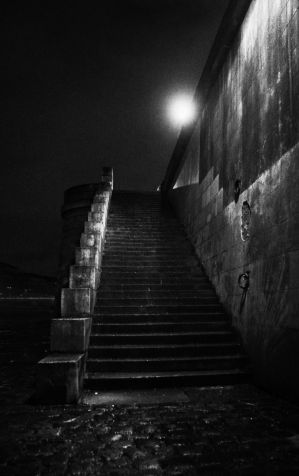
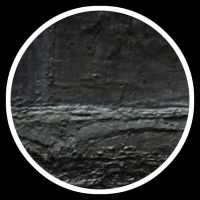
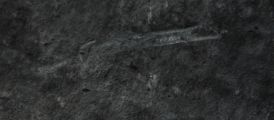
The choice of a light is carrying a vision, for both inner and outside vision.
The light on the stairway is an explicit reference to the lighting of film noirs, which could suggest the lighting of a crime scene.
Time is suspended, the viewer is invited to enter himself in the painting and continue the scene.

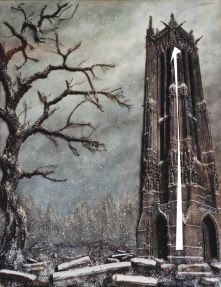
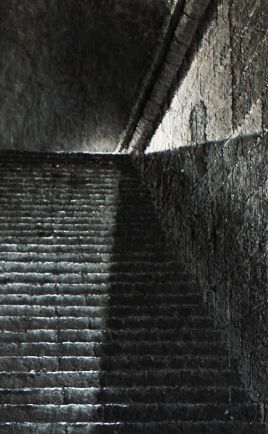
One could believe that the river is about to become a furious sea. Some kind of modern flood that is reviving a link with a universal theme already covered by Great Ancients.
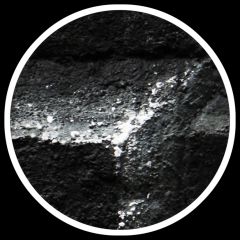
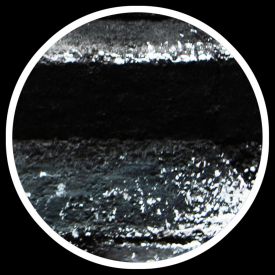
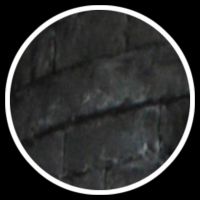
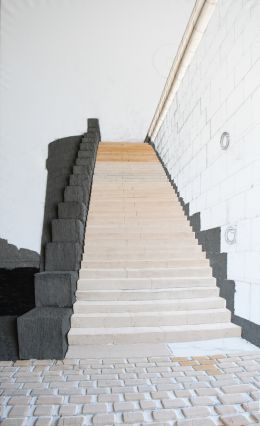
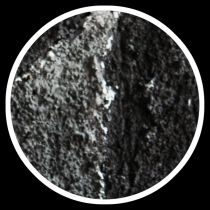
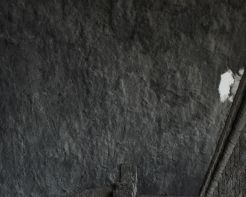
Canvases are not varnished. This allow to keep the difference between dullness and gloss of the matters in order to let the external light plays its full role.
That way, the river is not painted. The external light only is reflecting on the embossed parts and shows the relief.
The river evokes a waiting, while the sky is unfolding and merges with the horizon.
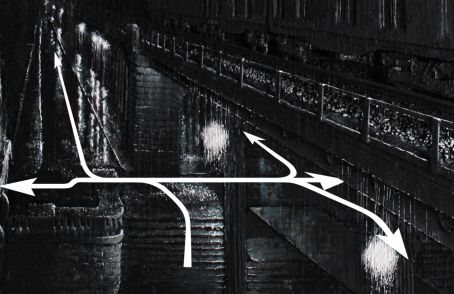
The orientation of the external light is integrated into the painting. According to the angle, height, scattering... the final result can be completly different.
Despite using a restricted number of paints, the chromatic scale is wide. Including dry pigments as well as paint or different textures from different matters, which bounce and capture the external light each in theyr own way.
Black for fresco is mainly reserved for the sky. It is used as a load in diluted paint, allowing the cotton to be tinted in mass. Light modulation is made by addition of dry pigments: Black for fresco for darkening, Titanium white for lightening. Thus, all the mass of the sky is made with a unique paint reference.
Cemented portions are made with cement tinted in mass (mix of cement and Ivory Black pigments), then tinted again with an underlayer of wood stain before the colouring process. Some tinctured portions are left exposed, allowing to get a very dark warm grey-brown.
Warm tones with greenish grey dominate in the top half of the painting, especially on the sky and the illuminated part of the wall. Warm tones still remain in the bottom part of the painting, but are conterbalanced by cold touches of grey-blue, more present in the shaded area of the wall and especially on the ground.
Lighted parts are made with a mix of plaster, Titanium white, and glue. Then they are progressively graded with light glazes of grey.
These multiple combinations of pigments/paints/matters are giving in the end a very wide chromatic range.
Black is not unique. Several different blacks have been used and combined with different matters: black for fresco as a paint load in the cotton, Ivory black mixed with artificial water or used as a load in paint on mineral matters. These blacks are giving the maximal opposition against the mix of plaster, glue and Titanium white.
Intermediary greys are given either by the matters themselves, either by different paints, either by modulation with loads of pigments, either by the external light which catches the volumes and cast real shadows in the hollows.
That's how shadows are built both by pigments and by the casting of real shadows.
Various shades of paint have been applied. Dry touches, highly diluted touches for the dark portions, glaze on plaster for the light portions.
Generally, the paint strokes are light and very fluid, the paint blends into the matters, but differences in texture between matters allow a great variety of effects. On the other hand, touches of light are most of the time very dense and embossed.
Direction of the strokes is significant: from down upwards for the shadow, from above downwards for the light, in both directions for a total shadow or a total light.
Details as rings are made of elements encased in matter, then painted and lighted.
Engraving is precise, volumes on the foreground are accentuated while the details on the background are left in a draft form.
Despite the small part left to improvisation, micro-accidents of the matters are integrated in the composition.
Organic matters are playing the role of a circulating void, inside of which stable mineral matters are filling space.
This way, the sky represent a moving surface opposite to the rays of light which are cutting the wall. It pull the stairway and the viewer far away in the background.
There is a separation between a world being abandoned and a world of uncertainty. Between a mineral block of deceptive stability and a constantly changing misty cloud.
The opposition between light and dark are intensified on the wall, the staircase and the pavement, but reduced in the sky. Some touches of grey-blue come as a conterpoint to the general warm tone of the whole painting.
Contrary to classic paintings in pigments, vision is not made of lines and colours, but of volumes and textures.
Material contrasts are coming in addition to pigment contrasts until they overcome them:
The changing organic texture of the cotton against the dense and stable texture of the cement. Reflective texture of artificial water opposed to matt and absorbent texture of the cotton. Smooth texture against grainy texture...
The opposition between mineral matters and organic matters determine the dynamic of the entire painting.
The distinction between the different textures is creating a clear separation between the planes. In turn, this distinction allow to increase the distancing effect.
Masses are balanced between the sky, the stairway, the wall, and the ground.
The balancing is a way to organize oppositions: oppositions between lights, oppositions between matters.
These side-roads cannot be compared to some kind of emergency exit. In the case of The Stairway, the path emerges on a choppy river and then on the mass of a stormy sky.
A way of escape provided on the periphery is establishing a new relation between central vision and peripheral vision. These way out can be found on other canvases like Nowhere, the Cathedral, The Casino...
The source point of sight is close to the ground, at child height. This point of view is very oftenly used: The Banks, Banks of Seine Pont Royal, Paris Eastern Railway Station, The Saint-Jacques Tower, Railway Station, The Street... This reinforces the dominance effect of the walls and emphasises the vertical perspective, while enlarging the foreground.
The extension of the space is highlighted by the absence of human presence.
The regular offset is creating a twisting perspective, which has already been used on previous paintings.
This particular perspective is bringing a kind of instability into dense mineral masses, oftently accompanied by ruins: the wall next to the Stairway is eroding, banks near the Cathedral are showing cracks, stones are scattered on the ground around the Saint-Jacques Tower. The arrow of time is shown at work.
The perspective is a complex system using multiple vanishing points, visible at first from the preparatory drawings.
Because of the canvas size, this multiple vanishing points system isn't immediatly discernable for someone standing in front of the painting.
The railing, in particular, has been built with an inner side made of regularly staggered vanishing lines.
The composition is embeded in a succession of interconnected squares and triangles.
The skyline is located on the bottom line of the big square.
The background light-source, located in the bottom right corner of the small square, represent the focal point from where the main lines are radiating: shadows, top of the stairs, top of the wall, projected light.
Although this light-source is hidden, it represent the most important place of the painting.
The horizontals of the stairs are creating a regular rythm, troubled by the shadow's diagonal.
The only circular forms are coming from the light and the rings.
The light reflect coming from the street lamp on the top is following the general shape of a sinuous line. It is one of the only curve in the composition.
The stairway is connecting Earth and Heaven. It replace the verticals, whose role has been diminished.
There have been some pentimenti on the canvas during its development, especially the light reflect. Firstly located on the left, it has been moved on the right.
The sky is made of several layers of cotton dyed in the whole mass with a mix of paint and dry pigments. A curtain of yarns has been laid over the first coats in order to structure the rain, then it has been recovered with new layers of cotton.
The river has been started with a layer of artificial water (polyurethane aqueous solution) mixed with Ivory Black.
Then a layer of cement has been applied onto which a sheet of aluminium foil has been adhered, the whole has been recovered in turn with a mix of dry pigment Ivory Black and artificial water.
A drawing is always made on the canvas before the implementation of the matters.
Pre-volumes are made initially with balza wood. This very lightweight wood is used firstly for preparing the volumes, and secondly to reduce the final weight of the canvas.
A first laying of matters has been done with cement. Then additional coats of cement mixed with sand and gravels have been added.
Sand and gravels have been collected on site, and so are coming from the original location of the subject.
The canvas is in large size for this kind of techniques: 80x130 cm with a ratio length/width of 1,625 very close to the golden ratio (1,618).
The starting point of this canvas is coming with a photo taken on the spot. The next step consisting in a work on the picture including changes in framing, composition, and light.
A comparison between the photo and the final painting allow to appreciate the differences in light, and more subtle changes in perspectives.
The point is to go beyond the photo, which role is mainly to keep a memory of forms. The mind's vision being expected to emerge during the entire construction process.
This canvas took a long time of work. Light control having to be very precisely calibrated. The second challenge is coming from the large size of the painting, which increase the area covered by matters.
Artwork on the painting is always done in the studio, integrating an instantaneus raw vision into a long-time elaborate vision on the canvas. Despite the duration of the labor, the painting is always keeping a part of the immediacy of the original snapshot in its underlying shapes.
The biggest differences from the original photography can be found in the treatment of light: the off-screen light source located on high has been removed, highlights have been strongly intensified while the ground surface has been more wetted.
The shadows on the stairs and the wall have been strengthened and extended. The sky brightness has been reworked. The light from the street lamp has been hardened. The hidden light source behind the stairs has been intensified. Perspective on the foreground has been slightly enlarged to give more presence to the matter. And the stairway's perspective has undergone imperceptible changes at first glance.
Framing attempts with off-centered or partially off-screen staircase have been conducted, but a balancing of the masses between the stairway, the ground, the wall, and the sky has been prefered.
It is signed on the top left with a stamp. On the back is written a list of the used components, a date and a counter-signature.
The canvas has been carried out mostly with daylight coming from the right, oriented South East. It has also been partly done with artificial light coming from the left.
This painting is designed to be shown with a rather frontal lighting located high up, slightly offseted on the right.
We are standing in front of the stairway of the 'Quai de l'Horloge' on the banks of Seine in Paris.
This painting has been made during almost all the year 2019 until the first months of 2020, more then a year of work.
Its first exhibition took place in Paris in early March. The exhibition has been first extended for two more weeks, then suspended because of the implementation of the containment. It has been exhibited another time in June 2020.
2019-2020 is closing a decade in which there have been not only eight of the warmest years ever recorded,
but also the spread of the corona virus which started in December 2019. It leaded entire areas to be placed under quarantine, with towns under containment showing streets emptied of theyr inhabitants.
In front a stairway, on the right a wall on the whole side, on the left a bank by the river, in the background stands a block of buildings and a bridge.
The block of buidings look like an indeterminate form which is blending into the skyline.
Two rings are embedded into the wall. The coating let appear rough stones in some places.
Embossed paving stones occupies the foreground. Rain drops and light reflection are indicating a falling rain.
The painting is in black and white.
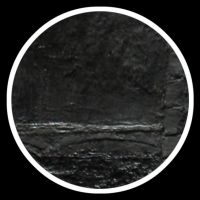
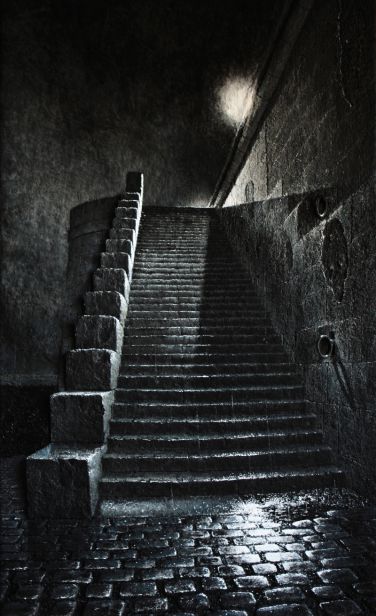
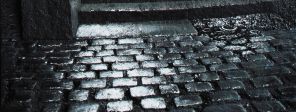
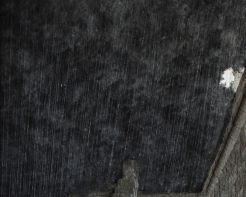
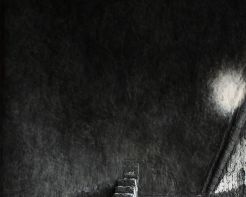
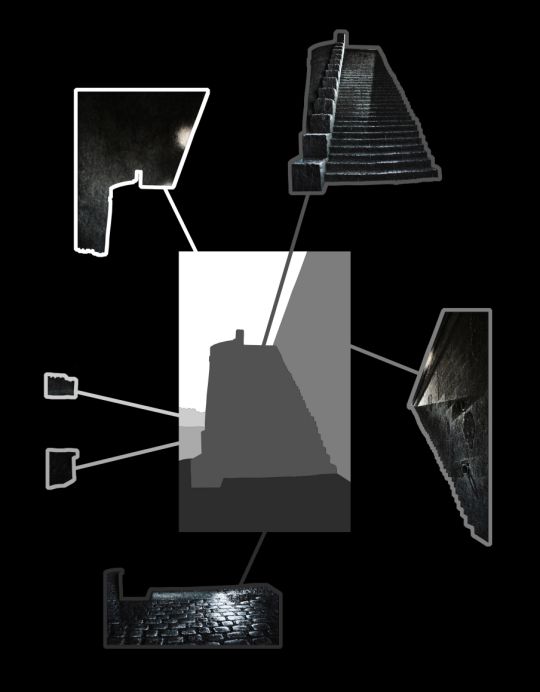

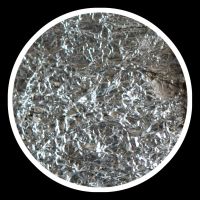
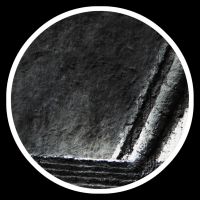
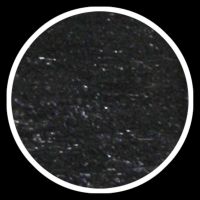
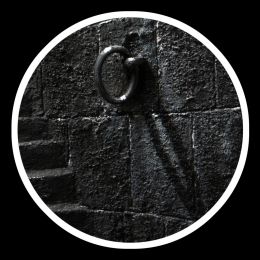
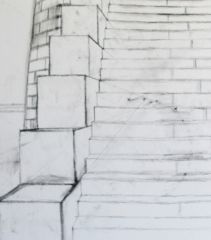
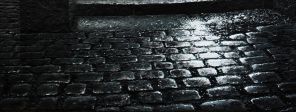
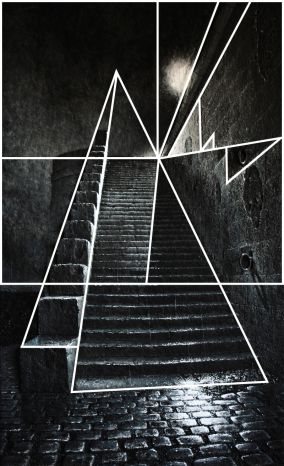
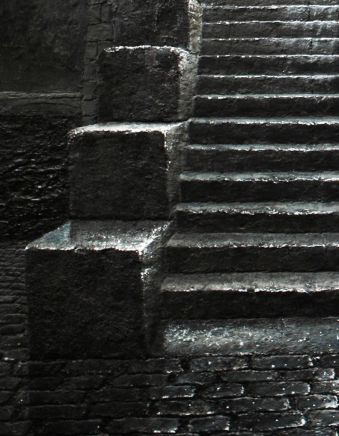
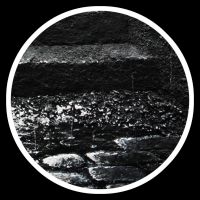

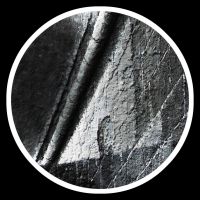

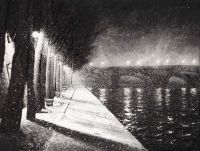

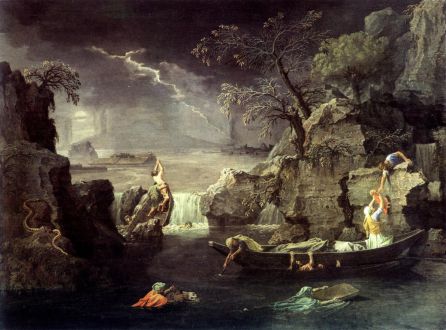

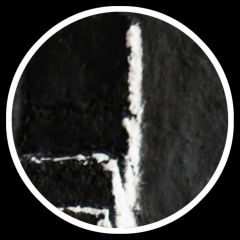

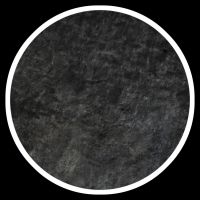
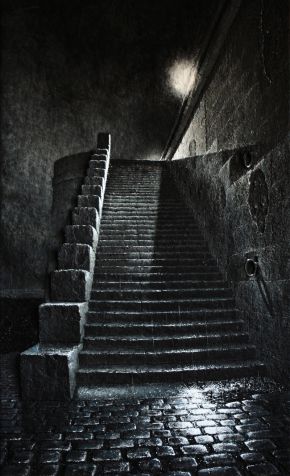
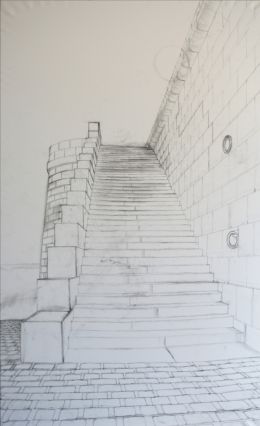

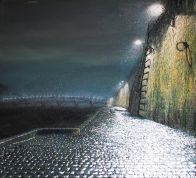
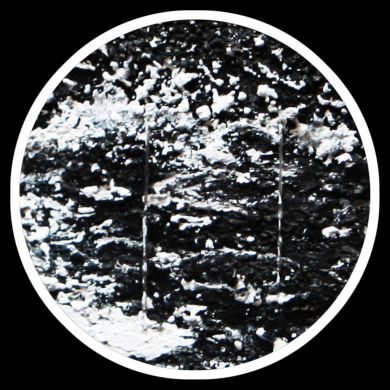
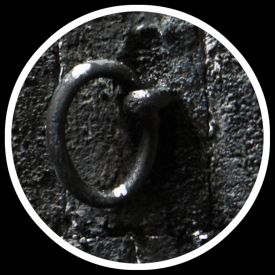
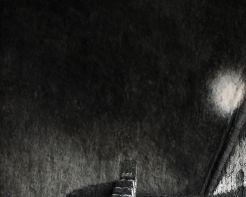
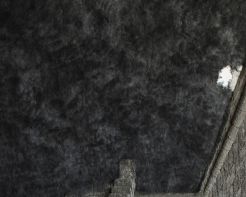






Fr
Eng
Paintings and matters on canvas
Luc Dartois

Pictures, texts, videos, illustration and logos contained on this website are exclusive property of Luc Dartois.
Any other use then strictly private use, any public distribution without author's permission iis prohibited.
Copyright © Luc Dartois